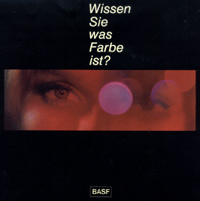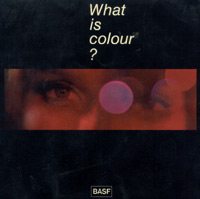Interview and article Produced
by Badische Anilin & Soda-Fabrik AG
 |
 |
| german version |
english version |
With brush and palette...
In Munich's quartier latin lives the painter Oswald Malura. I visit him
in his atelier, from which there is a wonderful view over the roofs of
Schwabing.
After exchanging a few pleasantries, we soon get down to discussing the
object of my visit, and I am fascinated by the manner in which this artist
describes his aspect of colour:
The creation of the world marked the birth of colour, that glowing, sonorous
prime element which forms the basis of all the beauty of our existence.
It is not surprising, therefore, that painting occupies a very special
position among the divine arts, as Leonardo da Vinci expressed it in his
arguments and his treatises. He gave preference to the art of colourful,
graphic representation over all other branches of art. It is fascinating
to imagine how man made his first attempt to draw pictures with black
and red-brown colours on cave walls, and finally succeeded in obtaining
outlines of animals and people. That was the beginning of painting. It
conferred plastic vision on mankind. Artistic expression became increasingly
rich and complicated in the course of the centuries. China, India and
Egypt have left us magnificent products of their colourful art from various
epochs. European painters have also left us an immense fortune of works
of art in the course of the centuries. This is a veritable triumph of
colour. And it continues unabated, even to-day. In all spheres of life,
colour has become the dominating factor. Colour is a world power whose
influence reaches out in all directions.
It was Goethe's study of colour that formed the basis on which a real
understanding of the phenomenon of colour can be gained. His research
in this field made him the first man to have a comprehensive, clear idea
of what colour is. Everything that had been thought or written before
him was fragmentary and completely inadequate, although it may have pointed
in the right direction. It was the genius Goethe who first elevated the
study of colour to a profound science. He was quite justified in saying
of himself: "Everything that I have achieved as a poet does not make
me feel proud. What I am pround of, and what gives me the feeling of superiority
over many other people, is the fact that I am the only one in my century
who knows what is right in the difficult science of colour." Oswald
Malura continues: We may obtain a better insight if we disregard modern
painting for the time being and observe a painter who has put up his easel
in the open, in the midst of the scenery he is painting - as in the days
of Corot and Cezanne. Only a beginner attempts to produce a photographic
reproduction true to nature. The faithfulness of his reproduction depends
on his power of observation and impressions. He is not yet concerned with
the law of picture composition and the effect of colour; he simply paints
what his eye sees. A master painter does not do this. The way he selects
his subject and places it in his picture - what he calls his "composition"
- and also the way he handles colours are quite different.
The beginner just copies what he sees, whereas the artist sets each colour
deliberately in relation to a uniform whole. He determines the colour-fullness
of the picture and promotes or suppresses the shades, until he sets the
accent at the end. A good example for this is Corot's The Bridge in a
Munich collection. The dominant colour of the whole picture is an ochre-yellowish
grey. The only contrast is a woman who is crossing the bridge. She wears
a blue apron. Without this accent, the picture would be monotonous and
incomplete. This blue accent in the picture fulfils a function similar
to that of counterpoint in music. Or look at this aquarelle by Paul Klee.
It was made in 1929 and its title is Luftfagdscene. You can see here quite
clearly how the whole composition is held together by the colourful central
point.
 |
 |
What Rembrandt succeeded in producing in his inimitable masterpieces
of colour transparency and density, occurs again later in Paul Cezanne's
paintings in a form that is easier for us to understand. No other painter
of this epoch offers us this composition of colours which can only be
created by one who knows the law of colour. Nothing here is haphazard
or at random. The colours are set in an organic arrangement like the stones
in a wall. The colour values are graduated with almost mathematical precision.
Cezanne's work shows the beginning of the development towards the cubism
of Picasso and Braque. Something quite new has come to life in the field
of painting. Hitherto unknown values of colourful experience and impression
rise to the surface, form certain arrangements, and break all the old
laws of painting. Before Cezanne dies, the first abstract picture is born.
And now the development proceeds at a steadily increasing rate. All bridges
to the past are burnt. A revolutionary change takes place in painting.
Kandinsky with his Blue Rider, Marc, Macke and Klee make great strides
forward. There is no longer any restriction to the development of colour
in its full intensity. "Away from illustrations' Painting as an art
for itself" is now the slogan. In 1913 the French painter Delaunay
writes "Colour is form and subject. It alone is the theme that develops
itself and changes outside of any analysis - be it psychological or otherwise.
Colour is a function for itself. Its activity is effective at all times
and in every development." Didn't fascination with a colour sometimes
go to such extremes that artists worked for whole periods completely in
one colour? You mentioned Picasso ... Quite right! Picasso had a "blue"
period and a "pink"' period. The blue period was around 1901,
when he created pictures such as the Ironing Woman and the Absinth Drinker.
The pink period with scenes from the world of the circus was from 1905.
What about the old masters?
They also had epochs characterized by certain colour combinations. The
Veronesians with their warm golden shades are a good example. You have
also heard of Tizian red, van Dyck brown and Rembrandt brown. Each painter
developed his own characteristic shades. They prepared their colours by
their own recipes, which they kept strictly secret even from their own
colleagues.
What are the oldest colours used in painting?
Oh, we would have to go back tens of thousands of years. When the cave
paintings from the last ice-age were discovered, stone grinding dishes
containing mineral colours were also found. They were mainly red ochre,
black manganese earth, red chalk, and iron oxides. Mr. Malura, how does
the painter of an abstract picture create the fascination of colours?
| Colour lives by itself and
it does not require any motive from the world we live in. In abstract
painting the painter's only object is to arrange colours in a picture
to create the mysterious composition which appeals to the observer
or moves or excites him. If I have just one blue on the canvas before
me, and it is a particularly beautiful blue, it will appeal to me
but it will not satisfy me for long. I am forced to use variations
of this blue surface by mixing the blue values with red or green.
The surface now comes to life, but I am not yet satisfied. It is only
when I introduce the contrast colour orange into this blue that I
have tension. The blue in the picture has its complementary colour.
Similarly, every shade demands its complementary colour, and until
it has it, there is no peace. Of course, that does not solve the whole
problem. It all depends on how it is done. It makes a great difference,
which orange I select. It must be the orange which corresponds to
this blue in the picture. |
|
The painter of today needs not only a strong sense of feeling; he must
have profound knowledge of what colour is.
|

